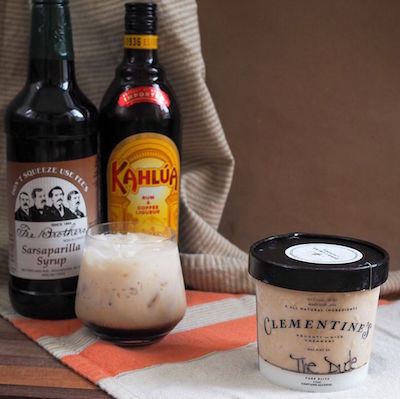

#Clementine ice cream how to
Back then I’d taken to cutting recipes out of supermarket magazines while I was learning how to cook for my new family. It has many, many years since I last made an ice cream bombe – 14 or 15 of them, to be honest. If the egg pops up too much above the water, add more water (or more juice, in case you so prefer).Something a little different for Christmas pudding.

Check how the egg behaves – if the egg becomes too submersed, add more sugar. But in case you have none, you could still rely on the trusty ol’ Egg test!Ĭarefully wash a fresh, raw egg. That is all very well if you have some instruments for measuring (like a sugar scale/saccarometer or a refractometer). Still, a common rule of thumbs for sweet sorbets would be to aim for a sugary sweetness level of about 31º Brix /17º Baumé. To some extent, the final sugar amount is a matter of personal taste: some like it sweeter, others don’t. Clearly, what we are looking for is the golden balance! Too much sugar, on the other hand, will not only make the sorbet sickeningly sweet but also cause it to remain too soft even after hours in the freezer. Too little sugar will make the final sorbet unpleasantly icy and hard-frozen. This is not only a matter of flavour and sweetness – the sugar actually helps to build up the consistency of the sorbet. Regardless of whether you use sugar syrup or sugar straight into the fruit juice, you would need to add only as much as the sorbet requires. If you plan on making a quantity of sugar syrup and save for later in the fridge, I would strongly suggest that you follow this method, as it would increase the shelf-life of your simple syrup (later, when the transparent liquid begins to turn cloudy, or otherwise mouldy, you know it is time to throw it away).īut for quick use, you may as well simply stir or shake (cold) water with sugar until the latter has dissolved completely – then, you do not have to worry about any cooling-down period before using the sugar syrup.Īdding the correct amount of sugar, using fancy instruments … or a raw egg Going by the classic recipes, the fusion of water and sugar should be brought about by heating the mixture to a simmering boil. The proportions of these two may vary depending on the flavour of the sorbet, but equal parts sugar and water is a tested and well-known general formula. Simple sugar syrup is, as you may know, simply a mix of water and sugar. But then again, I have friends who like the opposite, so follow your own preferences on this). While you could make a sorbet by simply adding a sufficient amount of sugar straight to the fruit juice, I decided to take the somewhat more economical step of mixing the fruit juice with sugar syrup (this is, however, not only a matter of economics – I actually prefer the overall flavour somewhat ‘diluted’ and less sweet: using only pure juice and sugar often tend to make the sorbets a bit too sweet for my taste. While much can be said about using ready-made fruit juice, one thing is clear: it makes sorbet preparations almost effortless In other words, only use the best available, pure fruit juice you can get hold of! Any additives put into the juice is likely to affect the taste, and could degrade the final result. Still, the general wisdom of frozen dessert-production applies: the sorbet only becomes as good as its ingredients. Using ready-made fruit juice turns the process into child’s play, really: if you manage to add (an appropriate amount of) sugar and some water to the Clementine juice, you are basically there! While I encourage everyone who so desires to go out and squeeze their own Clementine juice straight from the fruits, I needed a quick fix for fastest possible results: ready-made fruit juice!

Sounds like a really fortunate base for a sorbet, does it not?Ī super simple recipe: take fruit juice, add sugar (and possibly some water) Mandarin oranges are particularly popular around Christmas time in some countries, and during the Chinese New Year, they are supposed to symbolise abundance and good fortune. Typically, they are juicy, sweet (having less acidity than oranges), seedless and easy to peel. The Clementine is a mandarin orange (i e from the same family as tangerines and satsumas). There, many believe he created the first Clementines through cross-breeding. The Clementine was named after this French missionary, in charge of the fruit gardens of an Algerian orphanage in Misserghin, in the Oran province. The Clementine – proud member of the mandarin orange familyīrother Marie-Clément Rodier (1839–1904).


 0 kommentar(er)
0 kommentar(er)
